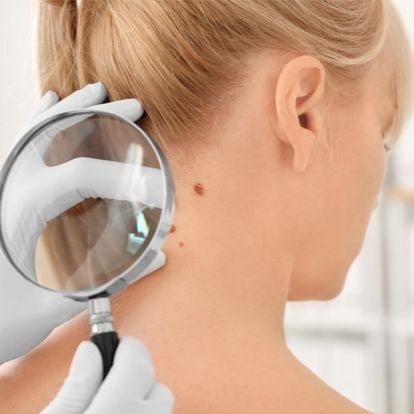 OVERVIEW
OVERVIEW
One of the most commonly occurring types of cancer in the United States, skin cancer affects approximately 3.3 million people each year. Reducing your exposure to UV rays is one of the best ways of preventing many skin cancers from developing—in fact, exposure to UV rays results in the formation of almost 90% of all melanomas.
What is Skin Cancer?
Skin cancer is one of the most common types of cancer in the United States. It occurs as a result of cells in your body growing out of control—in this case, it is skin cells that rapidly grow and form growths that can be benign or malignant in nature.
According to the Centers for Disease Control & Prevention, basal cell carcinoma and squamous cell carcinomas are the two most regularly occurring types of skin cancer. Known as nonmelanoma skin cancers, they begin in the squamous and basal cell layers of your skin's outer surface, known as the epidermis.
Melanoma, the other type of skin cancer, begins in the melanocytes. Despite being much less common than basal cell cancer and squamous cell cancer, melanomas are more severe due to their ability to metastasize and spread to other parts of the body. Melanoma currently accounts for approximately 8,700 deaths each year.
What are the Causes of Skin Cancer?
The most common reason why skin cancer occurs is exposure to UV radiation from the sun or artificial sources such as tanning beds. Avoiding getting sunburned can significantly decrease your risk of melanoma.
However, other risk factors may make you more predisposed to developing skin cancer. These can include:
- Genetics
- Fair skin, red or blonde hair, and light eyes
- Moles
- Exposure to chemicals like arsenic
- Gender: men, in general, are more likely to develop skin cancer than women
- Age
What are the Symptoms of Skin Cancer?
According to WebMD, skin cancers start as changes to your skin, including the development of new growths, changes to existing moles, or lesions that do not heal.
The ABCDEs are an excellent way to watch out for the symptoms of skin cancer:
- Asymmetrical: does the growth have an irregular shape
- Border: does it have a jagged border
- Color: does it have multiple shades in the bump
- Diameter: is the mole larger than the size of a pea?
- Evolving: has it grown or changed in an appearance recently?
How is Skin Cancer Diagnosed?
Any new, unusual, changing, or symptomatic growth should prompt a visit to your dermatologist. If you have risk factors (personal or family history of skin cancers, transplant recipient, significant sun exposure or tanning bed use in the past, etc), scheduling regular appointments with your dermatologist can help with accurate and timely diagnosis and treatment of skin cancers.
At your visit, your dermatologist will evaluate your skin and any lesions or growths of concern. A skin biopsy (a procedure that removes a small sample of the skin) is usually done to confirm a definitive diagnosis. Once the diagnosis has been confirmed, your dermatologist will discuss treatment options.
Treatment for Skin Cancer is Safe When Performed by a Board-Certified Dermatologist
For skin cancers that are caught early, treatment by your dermatologist can be effective and prevent them from developing early. Treatment will depend on:
- the type of skin cancer
- stage of skin cancer
- the size of the tumor and where it is on the body
- your overall health
Typical forms of treatment for skin cancer include:
- Simple excision surgery
This procedure involves removing the tumor and surrounding tissue from the skin. - Curettage and electrodesiccation
Commonly known as electrosurgery, this procedure involves using a curette to cut the tumor from the skin. An electronic needle is then used to kill the cancer cells that remain around the wound. - Cryosurgery
Freezing and destroying the cancer cells with the use of liquid nitrogen. - Radiation therapy
Best used to treat nonmelanoma skin cancers, this procedure uses high-energy radiation to kill cancer cells and prevent future growth.
 OVERVIEW
OVERVIEW
